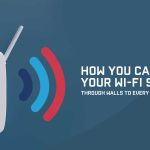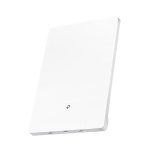To extend your WiFi signal to another building 200 feet away, consider using a high-gain outdoor WiFi antenna or a long-range WiFi extender. Installing a point-to-point WiFi bridge or deploying mesh networking systems can also do the trick. These solutions ensure a stable, fast connection across the distance, keeping you connected no matter where you are.
If you’re wondering how to boost your WiFi to reach that second building 200 feet away, the key is to use powerful outdoor equipment designed for long-range signals. Investing in outdoor antennas or dedicated wireless bridges can create a seamless link, allowing high-speed internet access across greater distances. With the right setup, you’ll enjoy reliable coverage without the need for running Ethernet cables or moving your existing router.
When trying to extend your WiFi to another building 200 feet away, start by evaluating your current setup and environment. External obstacles like walls, trees, or buildings can significantly weaken signals, so selecting equipment built for outdoor, long-distance use is crucial. Outdoor directional antennas or dedicated point-to-point bridges focus the signal directly between the two locations, providing a robust and efficient connection. Setting up such systems is typically straightforward, and the investment ensures you stay connected in both buildings without sacrificing speed or stability.
How do I extend my WiFi signal to another building 200 feet away?
Extending your WiFi signal over long distances can seem tricky, but it’s quite manageable with the right tools and setup. When your other building is 200 feet away, you’ll need to consider several factors like obstacles, signal strength, and the best equipment. In this section, we’ll explore the most effective ways to make sure your WiFi reaches that distant building clearly and reliably.
Understanding WiFi Signal Range and Limitations
WiFi signals generally have a limited range, which depends on the frequency band and environment. Typically, a standard router can cover about 30 to 50 feet indoors and up to 300 feet outdoors under ideal conditions. However, walls, trees, and buildings can weaken signals significantly, especially over longer distances.
At 200 feet, the signal can become weak or unstable without proper setup. This is because obstacles and interference reduce signal strength, and WiFi signals naturally attenuate over distance. Knowing these limits helps determine the best approach to extend your coverage successfully.
Choosing Between WiFi Repeaters, Extenders, and Access Points
Let’s look at three common options to extend WiFi signals over longer distances:
- WiFi Repeaters: They receive your existing WiFi signal and rebroadcast it. They’re easy to set up but may reduce overall network speed.
- WiFi Range Extenders: Similar to repeaters, extenders amplify signals but often better suited for larger distances and can support multiple devices.
- Wireless Access Points (APs): These are connected via Ethernet cables and provide a new WiFi access point in a different location. They offer the best performance and stability over long distances, especially when connected through wired connections.
For a distance of 200 feet, using an access point connected by Ethernet usually provides the best reliability. If cabling isn’t feasible, high-quality repeaters or extenders can still work with the right setup.
Using a Point-to-Point WiFi Bridge
A point-to-point WiFi bridge is one of the most effective solutions for connecting two buildings over 200 feet. It creates a dedicated wireless link that acts like a virtual cable once installed.
This setup involves two specialized devices called bridging antennas or access points with directional antennas. These antennas focus the WiFi signals directly toward each other, minimizing interference and maximizing range.
Benefits of WiFi Bridges:
- Strong, stable connection over long distances
- Less interference compared to omnidirectional signals
- Higher data transfer speeds suitable for multiple devices and activities
Choosing the Right Equipment for Long-Distance WiFi
When selecting equipment for extending WiFi to another building 200 feet away, consider these factors:
| Device Type | Recommended Range | Pros | Cons |
|---|---|---|---|
| Directional Antennas | Up to 2 miles | Focused signals, long-range | Requires precise alignment |
| Wireless Bridge Units | Up to 1 mile and more | Reliable link over long distances | Higher cost, setup complexity |
| High-Gain Extenders | Up to 300 feet outdoors | Easy to install | Potential speed reduction |
Opt for devices that support the latest WiFi standards, such as WiFi 6, for better throughput and future-proofing. High-gain directional antennas are particularly effective for long-distance links.
Positioning and Installing Equipment Correctly
Proper placement of your equipment is essential for optimal performance. For a point-to-point bridge, install the antennas outdoors on both buildings, ideally at a high point like a roof or tower.
Ensure the antennas face each other directly with minimal obstacles in the line of sight. Clear obstacles such as trees, remote structures, or hills improve the signal and reduce interference.
Alignment and Testing:
- Use a signal strength meter to align antennas accurately.
- Check the connection stability periodically.
- Adjust the angle for maximum signal strength and minimal interference.
Considering Ethernet Extension Options
If you’re open to wired solutions, Ethernet is the most reliable method for extending your WiFi. Use a high-quality outdoor Ethernet cable to connect a router or access point in your main building to a receiving device in the other building.
Keep in mind that Ethernet cables can run up to 328 feet (100 meters) without signal boosters or repeaters. For longer distances, consider using Ethernet extenders or fiber-optic cables for seamless connectivity.
Advantages of Wired Ethernet:
- High stability and speed
- Less interference from external sources
- Supports high-bandwidth activities like streaming or data transfer
Additional Tips for Improving WiFi Range and Performance
Beyond choosing the right equipment, you can implement some simple tips to enhance your WiFi connection:
- Reduce interference: Keep routers and antennas away from microwave ovens, cordless phones, and metal objects.
- Use Quality Cables: If installing Ethernet, opt for outdoor-rated, shielded cables for durability and performance.
- Upgrade firmware: Ensure your devices have the latest firmware for improved features and security.
- Secure your network: Use strong passwords to prevent unauthorized access and interference.
- Optimal placement: Position your router and antennas in central, elevated locations to maximize coverage.
Considering Weather and Environmental Factors
Outdoor installations are susceptible to weather conditions like rain, snow, or high winds, which can affect antenna stability and signal quality.
Use weatherproof enclosures and durable mounting hardware to protect equipment. Additionally, plan your setup during periods of favorable weather to avoid interruptions.
Testing and Troubleshooting Your Long-Distance WiFi Link
Once installed, regularly test your connection’s speed and stability. Use tools like ping tests and speed tests to ensure your WiFi performs as expected.
If issues arise, check for obstructions, realign antennas, update firmware, and verify cable connections. Troubleshooting patiently can resolve most problems quickly.
Summary: Best Practices for Extending WiFi Over 200 Feet
Effective extension of WiFi over long distances involves selecting the right equipment such as directional antennas, wireless bridges or Ethernet cables. Proper positioning and alignment are crucial for optimal performance.
When possible, use wired connections for maximum stability and speed, but if wireless is necessary, high-gain antennas and point-to-point bridges are excellent choices. Regular testing and environmental considerations will help maintain a strong, reliable network connection between your buildings.
Easily Extend Your Home WiFi To Your Barn, Shed and Beyond!
Frequently Asked Questions
What types of equipment are best suited for extending WiFi to a distant building?
To extend WiFi to a building 200 feet away, consider using high-quality outdoor wireless antennas or access points specifically designed for long-distance connectivity. Directional antennas, such as Yagi or parabolic antennas, focus the signal in one direction, increasing range and strength. Alternatively, professional-grade outdoor access points with high transmit power and weatherproof enclosures can provide reliable coverage over extended distances. Ensure the equipment supports the appropriate WiFi standards, such as 802.11ac or 802.11ax, for optimal performance.
How can I improve the signal stability when extending WiFi to another building?
Achieving a stable connection over 200 feet requires minimizing obstacles and interference. Place the transmitting antenna on a high, unobstructed location to maximize line-of-sight access. Use high-gain antennas to focus the signal toward the receiving point. Keep the antenna connections secure and protected from weather elements. Reducing electronic interference from nearby devices and selecting a clear frequency band, such as 5 GHz, can also enhance stability. Regularly inspect equipment to maintain optimal performance and reduce signal degradation.
Are there any safety precautions I should consider when setting up long-distance WiFi links?
Yes, always ensure that all outdoor equipment is weatherproof and installed securely to prevent damage or accidents. Follow local regulations regarding the use of wireless antennas and transmitters, especially if they operate on high power levels. Maintain proper clearance from power lines and other critical infrastructure to avoid risks. Additionally, secure all equipment with strong passwords and encryption protocols to prevent unauthorized access and protect your network data. Regular maintenance and inspections help identify and address potential safety issues early.
Final Thoughts
To extend your WiFi signal to another building 200 feet away, consider using a WiFi range extender or a powerful outdoor access point. Position the device in a clear, unobstructed area for optimal coverage. You may also run an Ethernet cable to a high-gain outdoor antenna to boost the signal further.
How do I extend my WiFi signal to another building 200 feet away? Ensuring a strong and steady connection requires choosing the right equipment and placement. Proper setup makes the distance manageable and keeps your network stable.




